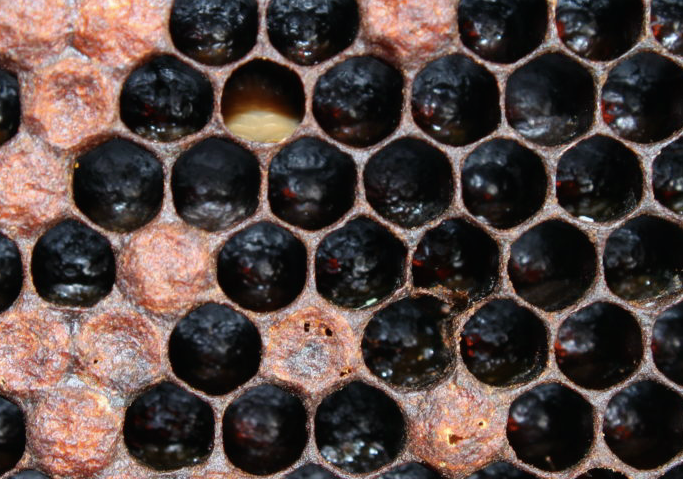
3 Deadly Bee Enemies Every Beekeeper Faces | How to Crush Them
Last week, we looked at best practices for tool and equipment maintenance. Today, we’ll take a closer look at some nearly invisible pests and diseases apiarists must be able to control to successfully manage their hives.
Honey bee enemy names and their details are mentioned below:
1. Varroa Mite
The varroa mite is one of the greatest threats to your bee colony because it can introduce various viruses to your hives. The varroa mite is thought to be the leading culprit of colony collapse disorder (CCD).
Fortunately, there are easy ways to test for the varroa mite; and, although it is often present in all hives, there are various treatments for the varroa mite when it becomes a problem.
Selective breeding programs are underway to develop a bee that is resistant to varroa. Bees are also being selectively bred that can detect the varroa mite inside a capped cell and will uncap the cell and interrupt the mite’s reproduction. Until all bees have this capability, you’ll want to test and treat the varroa mite yourself.
2. Nosema
Nosema, another disease that affects bees, has been linked to the serious decline of many colonies. Colonies infected with nosema are often decimated at an alarming rate. Many times, only a few dead and dying bees can be found near the hive’s entrance because infected bees often die far from the hive. Diagnosis of nosema must be made with a microscope; therefore, most apiarists send samples to a lab for diagnosis.
Although research is underway to discover alternative treatments for nosema, the only current treatment is fumagillin followed by a thorough hive clean up. Some apiarists have success with more natural means of nosema control.
3. American and European Foulbrood
Two serious diseases that can destroy hives are American foulbrood (AFB) and European foulbrood (EFB), with American foulbrood being the more serious of the two. European foulbrood can be treated with antibiotics. American foulbrood, on the other hand, will require more drastic measures.
AFB spreads through spores which can remain viable for more than 50 years. If AFB gets a foothold in one of your hives, it must be dealt with quickly to prevent its spread to other colonies. AFB does not affect adult bees; however, adult bees transport the spores to other colonies through drift and also through robbing activities.
Additionally, AFB spores travel on tools that are not cleaned after use between hives. When AFB has been discovered, extra care must be taken to fully clean every item of your beekeeping equipment to prevent further spread. Perform the following tasks:
- Using your hive tool, scrape wax and propolis from the wooden parts of the smoker bellows
- Using soapy water, scrub the bellows and base of your smoker
- Wash the outside of your gloves, scrubbing with soapy water. Although this won’t kill AFB spores, it will remove any honey, propolis or wax that is on the gloves which can contain measurable concentrations of spores
- Scrape propolis and wax from the hive tool
- Sterilize the hive tool by placing it into a hot firepot of the smoker and pumping on the bellows until a flame is produced
AFB spores are very difficult to kill, leaving a beekeeper with only two options for their colonies and hive components when dealing with AFB contamination. The first option is to kill the colony and then irradiate all box components, including the frames. When irradiation is not an option, place the entire hive in a deep pit. Burn and then bury the remains. When choosing the burn and bury option, make sure that all hive openings are secure so that no bees escape.
To prevent future spread of AFB and other pests between hives, consider implementing the practice of cleaning all tools before moving to work in the next hive.
~
General Questions About Bee Enemies
How often should I test for Varroa mites in my hives?
It’s recommended to test for Varroa mites at least once a month during the active season (spring through fall). Regular testing helps you monitor mite levels and take timely action to control infestations.
What are some natural treatments for Nosema?
Natural treatments for Nosema include maintaining strong, healthy colonies through good nutrition and proper hive management. Some beekeepers also use natural supplements like essential oils (e.g., thymol) and herbal teas to boost bee immunity and reduce Nosema spore counts.
How can I identify American Foulbrood (AFB) in my hive?
Signs of AFB include a patchy brood pattern, sunken and perforated capped brood cells, and a foul smell. Infected larvae will appear brown and gooey, and when a matchstick is inserted into the cell, the contents will rope out. Laboratory tests can confirm the presence of AFB spores.
Can European Foulbrood (EFB) be prevented without antibiotics?
While antibiotics are effective, good hive management practices can help prevent EFB. These include ensuring strong colonies, proper nutrition, and regular inspections. Some beekeepers also use natural treatments like essential oils to support bee health.
What should I do if I suspect my hive has American Foulbrood (AFB)?
If you suspect AFB, immediately quarantine the affected hive to prevent the spread. Contact your local beekeeping association or agricultural extension office for advice.




Leave a comment